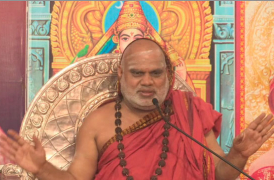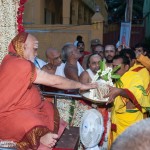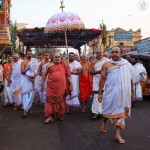
Rameswaram: MAY 17-19, 2012
At Holy Rameswaram: A Symbolism of Advaita
Jagadguru Shankaracharya Sri Sri Bharati Tirtha Mahaswamiji arrived at the holy Kshetram of Rameswaram on the evening of 17th May 2012. Crossing the Pamban bridge, the Jagadguru was received at the entrance of Rameswaram by the Mahajanas of this holy city. The Jagadguru had Darshan of Ganapati and was led in a grand procession through the Agrahara of Rameswaram that surrounds the Ramanathaswamy temple. It was a sight to behold as families residing around the temple for many centuries came out to welcome the Jagadguru.
The Jagadguru arrived at the Sringeri Shankara Math in Rameswaram adjacent to the temple. Dhuli Pada Puja was performed followed by a Samooha Pada Puja. This Samooha Pada Puja was perfomed in accordance to tradition that stretches back over a millenium and was done by 6 families representing the three Tamil Brahmana communities of Brihaccharanam, Vadama, Ashtasahasram; the Brahmana communities hailing from Maharashtra and Andhra and the Madhva community. Local leaders of the Hindu as well as Muslim communities then offered their Pranams to the Jagadguru. The Jagadguru expressed joy at the amity between the various communities in Rameswaram and blessed that they remain united in times to come.
In His Anugraha Bhashanam, the Jagadguru said that of all the Kshetras (holy towns) in the nation, Rameswaram is famous because Lord Parameshwara was consecrated by Sri Rama Himself and resides here. It is only here that we find the Linga consecrated by Sri Rama.
The Jagadguru then explained the significance of the word “Rameswara” by recounting an incident from the times of Sri Adi Shankaracharya. Sri Padmapada, one of the chief disciples of Sri Adi Shankaracharya undertook a pilgrimage and came to Rameswaram. The people of Rameswaram questioned Sri Padmapada on the significance of the word “Rameswara”. Sri Padmapada replied thus – Some people understand the meaning to be “the Lord of Rama”. Others would say “He for whom Sri Rama is the Lord”. Whereas we say that Rameswara is He who is Rama and He who is Ishwara.
This was stated by Sri Padmapada because essentially, there is no difference in the forms of Lord. People belonging to the first category who state the meaning as “the Lord of Rama” feel that Lord Shiva is greater than Sri Rama. The second category feel Sri Rama is greater than Lord Shiva. Neither of these is acceptable to us. Hence if some people explain the word “रामेश्वरः” using the Tatpurusha Samaasa as रामस्य ईश्वरः, and others use the Bahuvreehi Samaasa as रामः ईश्वरः यस्य सः, we Advaitins explain the identity of the forms of the Lord and explain the word using Karmadhaaraya Samaasa as रामश्चासौ ईश्वरश्च.
The Jagadguru emphasized the identity between Lord Shiva and Lord Vishnu by quoting the following Sanskrit verses:
शिवाय विष्णुरूपाय शिवरूपाय विष्णवे ।
शिवस्य हृदयं विष्णुर्विष्णोश्च हृदयं शिवः ॥
यथा शिवमयो विष्णुरेवं विष्णुमयः शिवः ।
Thus the notion of Advaita is present here in this Kshetram in the very name of the Lord. Hence this Kshetram gains even more significance and commands great respect from all of us.
The Jagadguru also said that while Sri Adi Shankaracharya had elaborated the Kshetram, Shakti, Mahavakya, Sampradaya etc. for the four Amnaya Peethams, He assigned the Kshetram of the Dakshinamnaya Sringeri Sharada Peetham as Rameswaram. Hence the Sringeri Acharyas themselves offer worship at Rameswaram and bless the devotees here. From the beginning, it had been decided that Archakas can offer Puja to the Lord only after receiving the Shiva Deeksha, Mantra Deeksha and Deeksha Nama from the Sringeri Jagadguru. The Jagadguru noted that all the Archakas engaged presently in the worship of Ramanathaswamy had taken Deeksha from Him.
The Jagadguru remembered His visits to Rameswara Kshetram. He had come along with His Guru, Jagadguru Sri Abhinava Vidyatirtha Mahaswamiji for the Kumbhabhishekam of the temple in 1975. He had also accompanied His Guru to Rameswaram in 1980 and observed Mahashivaratri here. Once again, He came to Rameswaram in 1987 and observed Mahashivaratri. On yet another occasion, the Jagadguru came to Rameswaram in 1995 after completing the tour of North India and in 2001 for the Kumbhabhisheka of the temple.
The Jagadguru stated that He had arrived at Rameswaram on the occasion of the current Dakshina Bharata Yatra to worship the Lord and bless all. It is very essential to secure God’s Grace in our lives irrespective of how much prosperity we may see. The residents of Rameswaram have the fortune of being able to have Darshan of the Lord daily.
Having said so, the Jagadguru remembered the words of Sri Neelakantha Deekshitar – नित्यं प्रयागवासी कूपस्नानं समाचरति. Many desire to go to Prayag and have the sacred bath in the Triveni Sangam – the confluence of the three holy rivers of Ganga, Yamuna and Saraswati. People who manage to go to Prayag take a dip in the Triveni Sangam, even if it is winter. However, people who live in Prayag do not take bath in the Triveni Sangam. Instead they simply use the water in their homes. However, there can be no doubt that the residents of Rameswaram are fortunate.
The Jagadguru said that the Sringeri Shankara Math in Rameswaram was quite ancient and renovation activity was initiated about 15 years ago. He added that He had performed Punah Prathishta Kumbhabhishekam of the Moorti of Sri Adi Shankara during the 2001 Kumbhabhisheka.
The Jagadguru said that by the Sankalpa of Goddess Sharada and the Grace of His Guru, the Peetham has undertaken the task to construct the south Gopuram of the temple. Such an effort in a Kshetram would yield a permanent result, will please the Lord and will give joy to the devotees. The Jagadguru invoked the Grace of the Lord for the fruition of this effort.
The Jagadguru expressed joy that the residents of Rameswaram had welcomed Him in accordance to the Sampradaya that exists and ended the Anugraha Bhashanam by blessing them.
The Jagadguru was then led in a procession as He walked to the Ramanathaswamy temple and entered the Southern corridor of the third Praakaara of the temple. The Jagadguru then performed His evening Snanam and Anushtanam in the temple premises and performed the Sharada Chandramoulishwara Puja.
At Sri Ramanathaswamy Temple and at Dhanushkodi
On May 18, the Jagadguru arrived at the the Ramanathaswamy temple at around 6:15 AM after His morning Anushtanams. The Jagadguru then proceeded for Snanam, then had Darshan of Lord Viswanathar adjacent to the main Garbha Griha and then entered the Garbha Griha of Lord Ramanathaswamy. After elaborate Abhishekas to the chants of Vedic mantras, the Jagadguru performed the Mangalarati to Lord Ramanathaswamy. The Jagadguru then offered worship to Goddess Parvata Vardhani.
After the Puja, granite blocks were sanctified just outside the Garbha Griha of the Goddess. These blocks were then carried towards the South Gopuram as the Jagadguru proceeded towards the construction site of the South Gopuram. Renowned Sthapatis, Ganapati Sthapati and his son Shankar Sthapati, in charge of the construction of the South Gopuram welcomed the Jagadguru. The granite frames of the entrance of the Gopuram was fixed in the Jagadguru’s presence after a short Puja by the Jagadguru.
In the evening, the Jagadguru once again performed the night Sharada Chandramoulishwara Puja and the Sri Chakra Puja in the southern corridor of the third Praakaara of Ramanathaswamy temple. While the Jagadguru was performing the Sri Chakra Puja, the Golden Palanquin Utsava of the Moorti of Goddess Parvati Vardhani took place along the third Praakaara of the temple. It was a delight for the devotees to watch the scene of the Goddess Herself coming to watch the Puja where the Jagadguru was worshipping Her own self in the form of the Sphatika Srichakra.
On the morning of May 19, after finishing His morning Anushtanams, the Jagadguru started for Dhanushkodi where the Jagadguru offered worship on the shores of the ocean – the meeting point of Mahodadhi and Ratnakara. The difference between the two oceans were clearly visible as one had waves gushing out while the other was calm. The Jagadguru performed the Puja and then entered the oceans and undertook Samudra Snanam. The Jagadguru returned to Rameswaram after blessing devotees.
Later that morning, the Jagadguru gave Darshan to the devotees and accepted the Bhiksha Vandanam and Pada Puja offered by the families living traditionally in the holy land of Rameswaram. The Jagadguru started for Sivagangai in the evening and en route graced the Sringeri Shankara Math in Manamadurai. The Jagadguru blessed the gathering with Anugraha Bhashanam and proceeded towards Sivagangai.





























































